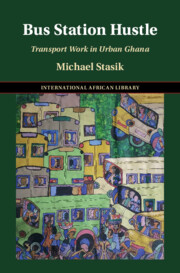Acknowledgements
Like the station hustle described in the following pages, this book is the result of much collective effort. I express my greatest gratitude to the people I had the chance to work with at Ghana’s bus stations. Despite my desire to personally recognise their contribution, most of their names will go unmentioned. Some of my key interlocutors, whom I prefer to refer to as my station seniors and colleagues, will figure prominently in the chapters to follow, but mostly under the guise of pseudonyms. This is to prevent my interpretations from jeopardising in any way their personal or professional reputation. I do wish to express my explicit thanks to Joseph Amu, Atsu Jenson, Ama Sewa, Kwabena Badu, Kwabena ‘Tall’ B. A. Sr and B. A. Jr, K. A. Seth, Alex ‘Ray Power’, Mr Owusu, Mr Larbi, Mr Daniel, Mr Kasim, Enoch, Rasford, and all the folks from Neoplan’s ‘French Embassy’, especially Victoria ‘Dede’, Mohammed, Abdoulaye, Amina, Abubakar, Abbas, and ‘Chairman’. Thank you for your trust, tolerance, and generosity.
While in Ghana, Samuel Aniegye Ntewusu was a very cordial host whenever I had the chance to be at the university, and he was a fantastic interlocutor for discussing the present and past of Ghanaian bus station life. Jan-Bart Gewald, who introduced me to Samuel, gave my research a decisive thrust during a talk we had in Accra just after I began doing fieldwork. I thank him for his continued dedication, which goes back to times before I embarked on this project. I owe much gratitude to wɔfa Kwame Fosu for tutoring me both in Twi and in various lorry park idioms. My warmest thanks to Auntie Emily Asiedu and Sister Dinah for making me feel at home in Accra.
The foundations for this project were laid during my time at the University of Bayreuth. The text presented in this book is very different from the dissertation I submitted there, but the ideas that run through it all bear the mark of that formation. While in Bayreuth, I was part of the research project ‘Travel and Roadside Communities’, which was set within the framework of the ‘Adaptation and Creativity in Africa’ programme (SPP 1448), funded by the German Research Foundation. Kurt Beck, who has been involved in both the project and the programme, has been my employer, adviser, colleague, friend, fellow fieldworker, and first and most thorough reviewer. I am deeply grateful for his time, support, and commitment. I have had the fortune to discuss many of the ideas presented in this book with Gabriel Klaeger and Rami Wadelnour. I have learned much from them, and not only in academic terms. I have also benefited from the debates and mutual support within the SPP 1448 group of Africanist researchers.
I thank my colleagues from the University of Bayreuth Anthropology Department and BIGSAS, the Max Planck Institute for the Study of Religious and Ethnic Diversity (MPI MMG), the University of Ghana MIASA, and the University of Basel, where, over the past years, I have had the chance to discuss, write, and revise different parts of this book. Co-editing the collections The Making of the African Road, Bus Stations in Africa, and Temporalities of Waiting in Africa provided a great opportunity to think through many related themes while probing into new thematic terrains, and so did the workshops and conference panels that preceded their production.
I furthermore want to thank Georg Klute, Ato Quayson, Sidy Cissokho, Anna-Riikka Kauppinen, Sara de Wit, Alena Thiel, Uli Beisel, and the MPI MMG writing group for reading and commenting on earlier versions of chapters, and for spurring me with questions, ideas, and critiques. For invitations to present and discuss parts of my work at different forums, I wish to thank Thomas Bierschenk, Gregor Dobler, Eveline Dürr, Julie Kleinman, Juliane Müller, Samuel Ntewusu (again), Michaela Pelican, Nikolaus Schareika, and Sophie Schramm. I am grateful to the IAL anonymous reviewers for their generous and constructive feedback.
I owe my gratitude to Matthias Gebauer né Fleischer for drawing the two maps included in this book. The Basel Mission Archives have kindly given me permission to reproduce one photograph. Portions of Chapter 5 originated as the article ‘Rhythm, resonance and kinaesthetic enskilment in a Ghanaian bus station’, published in Ethnos 82 (3): 545–68 (2017).
I dedicate this book to Zoe, Milos, Om, and Ela, whose patience and love have made this work possible.

